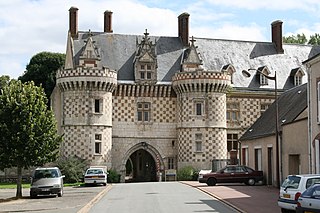
Saint-Amand Abbey (Abbaye de Saint-Amand), once known as Elno, Elnon or Elnone Abbey, is a former Benedictine abbey in Saint-Amand-les-Eaux, Nord, France.

Saint-Amand Abbey (Abbaye de Saint-Amand), once known as Elno, Elnon or Elnone Abbey, is a former Benedictine abbey in Saint-Amand-les-Eaux, Nord, France.
The abbey was founded around 633-639 [1] [2] in what was once a great tract of uninhabited land in the Vicoigne Forest between the Scarpe and the brook called the Elnon , from which the monastery took its first name, Elnon or Elnone Abbey. The founder was Saint Amand of Maastricht, under the patronage of Dagobert I. The name of the saint eventually became applied both to the abbey and the village that grew up round it. [3] The abbot from about 652 was Jonatus. [4]
Apart from its considerable effect on the landscape, the abbey became a major centre of study during the Carolingian Renaissance. Notable members of the community included the 9th-century writer Milo of Saint-Amand, author of a metrical dictionary of Latin long and short syllables [5] as well as a Life of Saint Amand, and his nephew, Hucbald of Saint-Amand, a noted music theorist and composer.
The abbey was totally destroyed by the Normans at the end of the 9th century. Although rebuilt, it was frequently destroyed by fire and the incidents of war, and was not completely restored until the 17th century, to an ambitious and much-admired plan implemented by Abbot Nicolas du Bois. In 1616-1617 Peter Paul Rubens painted a new high altarpiece for the monastery church, the Saint Stephen Triptych . [6]

In 1672, Dom Mabillon discovered that, at the end of a manuscript of works of Gregory Nazianzen, there is a praise poem of the late 9th century in Old German, the Ludwigslied , which commemorates the victory of the Frankish army of Louis III over the Vikings on 3 August 881 at the Battle of Saucourt-en-Vimeu. The same manuscript, now held at the municipal library of Valenciennes, was found to contain one of the earliest literary texts in vernacular French, the poem called Sequence of Saint Eulalia . The Annales sancti Amandi , a set of annals of the Frankish kingdom, also originate from Saint-Amand. [7]
The abbey was declared national property in 1789, and mostly demolished between 1797 and 1820. [8] The former courthouse (échevinage) and the exuberantly decorated church tower, which now accommodates a faience museum, survive and can still be visited.

Amandus, commonly called Saint Amand, was a bishop of Tongeren-Maastricht and one of the great Christian missionaries of Flanders. He is venerated as a saint, particularly in France and Belgium.

The Sequence of Saint Eulalia, also known as the Canticle of Saint Eulalia is the earliest surviving piece of French hagiography and one of the earliest extant texts in the vernacular langues d'oïl. It dates from around 880.

Saint-Amand-les-Eaux is a commune in the Nord department, northern France. It lies on the river Scarpe, 12 km northwest of Valenciennes. In French, the town people are named Amandinois (m), Amandinoise (f).

The Abbey of Saint-Victor is a former abbey that was founded during the late Roman period in Marseille in the south of France, named after the local soldier saint and martyr, Victor of Marseilles.

The Basilica of Saint-Martin d'Ainay is a Romanesque church in Ainay in the Presqu'île district in the historic centre of Lyon, France. A quintessential example of Romanesque architecture, it was inscribed on the UNESCO World Heritage List along with other notable buildings in the centre of Lyon as a testimony to Lyon's long history as an important European town and unique blend of architectural styles.

La Cambre Abbey or Ter Kameren Abbey is a former Cistercian abbey in the City of Brussels, Belgium. It is located in the Maelbeek valley between the Bois de la Cambre/Ter Kamerenbos and the Ixelles Ponds. The abbey church is a Catholic parish of the Archdiocese of Mechelen–Brussels and home to a community of Norbertine canons, while other parts of the monastery house the headquarters of the Belgian National Geographic Institute and La Cambre, a prestigious visual arts school.

Saint Germanus of Granfelden was the first abbot of Moutier-Grandval Abbey. He is venerated as a martyr saint in the Catholic and Eastern Orthodox Churches.

Saint-Amand-de-Coly is a former commune in the Dordogne department in Nouvelle-Aquitaine in southwestern France. On 1 January 2019, it was merged into the new commune Coly-Saint-Amand.

The Abbey of St. Bertin was a Benedictine monastic abbey in Saint-Omer, France. The buildings are now in ruins, which are open to the public. It was initially dedicated to St. Peter but was rededicated to its second abbot, St. Bertin. The abbey is known for its Latin cartulary whose first part is attributed to St. Folquin.

Bonneval Abbey, also known as St. Florentinus' Abbey, is a former Benedictine monastery in Bonneval, Eure-et-Loir, in France.

Anchin Abbey was a Benedictine monastery founded in 1079 in the commune of Pecquencourt in what is now the Nord department of France.

Marchiennes Abbey was a French monastery located on the Scarpe in Marchiennes. It was founded around 630 by Adalbard of Douai, and Irish monks, disciples of Saint Columbanus, on the advice of Saint Amand. One of its founders was Rictrude, who made it double monastery in 643. In around 1024 it became monastery of men again and adopted the Benedictine rule. On the birth of the town of Marchiennes the abbey became its economic motor until being suppressed in 1791 during the French Revolution. In 1814 all but its 1748 gatehouse was demolished. Its remains were inscribed on the inventory of monuments historiques on 17 May 1974,

Moissac Abbey was a Benedictine and Cluniac monastery in Moissac, Tarn-et-Garonne in south-western France. A number of its medieval buildings survive including the abbey church, which has a famous and important Romanesque sculpture around the entrance.

The Abbey of Saint-Savin-en-Lavedan was a Benedictine abbey in the commune of Saint-Savin, Hautes-Pyrénées, France. It was one of the most important religious centres in the County of Bigorre. The Romanesque abbey church remains, in use since 1790 as a parish church. It has been listed since 1840 as a monument historique by the French Ministry of Culture.
Adalbert I of Ostrevent was a 7th-century Frankish nobleman of the court of King Clovis II of France. He is recognized as a saint, and is commemorated on both 2 February and 2 May.

Nivelles Abbey is a former Imperial Abbey of the Holy Roman Empire founded in 640. It is located in Nivelles, Walloon Brabant, Belgium.
Preuilly Abbey was a Benedictine monastery in Preuilly-sur-Claise, Indre-et-Loire, France. The surviving abbey church retains many Romanesque features, notably the intricately carved capitals.

Saint-Maur Abbey, originally called the Abbaye des Fossés, is a former abbey now subsumed in the Saint-Maur-des-Fossés suburb of Paris, France. The remains and the domain of the abbey have been transformed into a pleasure park named Parc de l'abbaye. The former abbey building has been replaced by a square at the corner of Avenue de Condé and Rue de l'Abbaye. Some ruins remain, such as the Rabelais tower, the 19th century Bourières villa and the old fortifications. The remains of the abbey have been classified as historical monuments since June 13, 1988.

Solignac Abbey, or the Abbey of Saint-Peter and Saint Paul of Solignac, is an abbey in Solignac, near Limoges, in Haute-Vienne. It was founded around 631 AD by Saint Eligius (Éloi). The present buildings date to the 12th century, but have been modified many times since then. The abbey was dissolved during the French Revolution and the buildings were put to new uses, including a prison, boarding school, porcelain factory and seminary. As of 2021 there were plans to restore it back to its original function as a monastery.
Jonatus or Jonath was a Christian monk. He was a monk at the monastery of Elnone under Abbot Amandus. He served as the first abbot of the monastery of Marchiennes from 641, according to the Annals of Marchiennes. This monastery had been founded as a male community by Amandus, but Jonatus introduced nuns. This took place not long after he became abbot, according to the Chronicle of Marchiennes. The first nun was Rictrude.